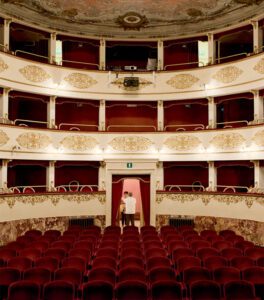
Although smaller and less famous than the Teatro la Fenice, the Teatro Goldoni in Venice has its history that we want to tell you about. First of all, few people know that this theatre, a few steps from San Marco, is the fourth oldest in the city, after Teatro Michiel, Teatro Tron and the Teatro di San Moisè.
Originally, the theatre was named after the family that built it in 1622, the Vendramin family, was enrolled in the Venetian patriciate since 1381, hence a family with certain importance and reputation in the city.
But when did the theatre take the name Teatro Goldoni? Let us take a step back in time.
History of the Goldoni Theatre
For the first thirty years, the theatre only hosted comedies, but after the fire of 1653 and its subsequent rebuilding, things changed and the new owners (Andrea and Zanetta Vendramin) delegated its management to third parties, with the agreement that they would be paid an annual income of 1000 ducats.
The theatre was beginning to be very successful, to the detriment of the other city theatres owned by a rival family: the Grimani. With a less than legal stratagem, the Grimani family removed the impresario Gaspare Torelli from Venice and the management of the Goldoni Theatre, obtaining it as a subcontractor. The Grimani family did not get away with this discourtesy and in 1689 the Vendramin family resumed running their theatre.
Carlo Goldoni made his first appearance here in 1734, but it was not until 1753 that the Vendramin managed to wrest it away from the Grimani and the San Samuele Theatre with a very advantageous contract, which allowed the playwright to produce his most famous and revolutionary works, such as Baruffe Chiozzotte and Sior Todaro Brontolon.
Goldoni then left for Paris, the theatre was renovated again and reopened in 1776, but due to the fall of the Serenissima in 1797 and the Vendramin family’s economic crisis, the theatre did not shine as brightly as in previous years. The theatre was closed in 1807, due to a directive of the Ministry of the Interior, which reduced theatres in proportion to population density.
The revival of the Goldoni Theatre
In 1817 the theatre reopened, after a series of structural interventions, and when the Teatro La Fenice was destroyed by a powerful fire in 1836, the performances scheduled for Carnival were moved to the Teatro Goldoni, which in the meantime had taken the name Teatro Apollo.
The theatre would carry this name until 1875 when actor Angelo Moro and owner Regina de Marchi (wife of the late Domenica Vendramin) decided to rename it Teatro Goldoni, in honour of the Venetian playwright.
It was no coincidence that the name change took place on the evening of 26 February 1875, the day after Carlo Goldoni’s birth (the date of the ceremony was moved up a day due to an unexpected snowfall).
Curiosities about the Goldoni Theatre
We would like to conclude this article about the history of the Goldoni Theatre with a peculiar detail: this theatre was the first in Italy to have gas lighting and complete illumination of the auditorium. This great innovation happened in 1844, thanks to Regina De Marchi, who did everything she could to make her late husband’s wish come true.